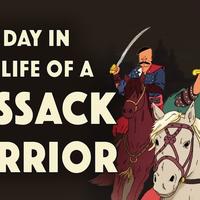A day in the life of a Cossack warrior - Alex Gendler
Despite a serene sunset on the Dnipro river,
the mood is tense for the Zaporozhian Cossacks.
The year is 1676, and the Treaty of Żurawno has officially ended hostilities
between the Polish-Lithuanian Commonwealth and the Ottoman Empire.
But as Stepan and his men ride towards their stronghold,
peace is far from their minds.
Having made their home in the Wild Fields north of the Black Sea,
these cossacks— derived from a Turkic word for "free man"—
are renowned as one of Europe's most formidable military forces.
Composed of hunters, fishermen, nomads and outlaws,
the Cossacks found freedom in these fertile unclaimed lands.
Yet this freedom has proven increasingly difficult to maintain.
Their decades-long strategy of shifting alliances between Poland and Moscow
has led to the partitioning of their lands.
In a desperate bid to reclaim independence and reunite the fractured Cossack state,
their most recent leader, hetman Petro Doroshenko allied with the Ottoman Empire.
This alliance successfully freed the Zaporozhian Cossacks
in the west from Polish dominion, but their victory was a bitter one.
Doroshenko's Ottoman allies ravaged the countryside,
carrying off peasants into slavery.
And outrage at allying with Muslims against fellow Christians
cost him any remaining local support.
Now, with Doroshenko deposed and exiled,
the Cossacks are at odds, disagreeing on what their next move should be.
Until then, Stepan must keep order.
With his musket and curved saber, he cuts an imposing figure.
He surveys his battalion of 180 men.
Most are Orthodox Christians and speak a Slavic language
that will become modern Ukrainian.
But there are also Greeks, Tatars, and even some Mongolian Kalmyks,
many with different opinions on recent events.
Officially, all of Stepan's men have sworn to uphold the Cossack code
by undergoing seven years of military training and remaining unmarried.
In practice, some are part-timers, holding more closely to their own traditions,
and maintaining families in nearby villages, outside Cossack lands.
Thankfully, the tenuous peace is not broken before they reach the Sich—
the center of Cossack military life.
Currently located at Chortomlyk,
the Sich's location shifts with the tide of military action.
The settlement is remarkably well- organized, with administrative buildings,
officers' quarters, and even schools, as Cossacks prize literacy.
Stepan and his men make their way to the barracks where they live and train
alongside several other battalions or kurins,
all of which make up a several hundred man regiment.
Inside, the men dine on dried fish, sheep's cheese, and salted pork fat—
along with plenty of wine.
Stepan instructs his friend Yuri to lighten the mood with his bandura.
But before long, an argument has broken out.
One of his men has raised a toast to Doroshenko.
Stepan cuts him off.
The room is silent until he raises his own toast to Ivan Sirko,
the new hetman who favors an alliance with Moscow against the Turks.
Stepan plans to support him, and he expects his men to do the same.
Suddenly, one of Sirko's men rushes in,
calling an emergency Rada, or general council meeting.
Stepan and the others make their way towards the church square—
the center of Sich life.
Ivan Sirko welcomes the confused crowd with exciting news—
scouts have located a large Ottoman camp completely vulnerable on one side.
Sirko vows that tomorrow, they will ride against their common enemy,
defend the Cossacks' autonomy, and bring unity to the Wild Fields.
As the men cheer in unison,
Stepan is relieved at their renewed sense of brotherhood.
Over the next 200 years, these freedom fighters would take on many foes.
And tragically,
they would eventually become the oppressive hand of the Russian government
they once opposed.
But today, these 17th century Cossacks
are remembered for their spirit of independence and defiance.
As the Russian painter Ilya Repin once said:
“No people in the world held freedom, equality, and fraternity so deeply.”

